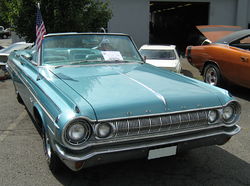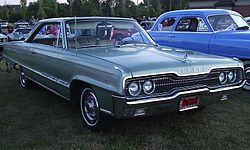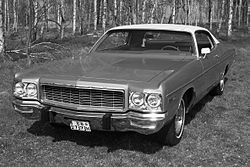- Dodge Polara
-
Dodge Polara 
Manufacturer Chrysler Corporation Production 1960–1973 Class Full-size Layout FR layout The Dodge Polara was an automobile introduced in the United States for the 1960 model year as Dodge's top-of-the-line full-size car; after the introduction of the Dodge Custom 880 in 1962, the Polara nameplate designated a step below the full sized best trimmed Dodge model; the Polara that year had been downsized to what as in effect intermediate status. In its various forms, the Polara name was used by Dodge until 1973, when its position in Dodge's line-up was replaced by the Dodge Monaco. The name Polara is a reference to the Polaris star, in a marketing attempt to appeal to the excitement surrounding the Space Race during the early 1960s. The Polara was a competitor to the Ford Galaxie 500 and the Chevrolet Impala.
1960 marked the first year that all Chrysler models, save the Imperial, used unibody construction.
Contents
1960–1961
First generation Production 1960–1961 Assembly Detroit, Michigan, United States Body style 4-door sedan
2-door coupe
2-door convertible
4-door station wagonWheelbase 3,099 mm (122.0 in)[1] Length 217.0 in (5,512 mm) [1] Related Dodge Dart
Dodge MatadorThe 1960 Polara and other full-sized Dodges featured styling cues carried over from 1959 models, itself an evolution of Virgil Exner's "Forward Look" cars introduced in 1957. The top-of-the line Polara and Dodge Matador continued to ride on the 122-inch (3,099 mm) wheelbase of their predecessors, while a new line-up of still full-sized Dodge Darts rode on a shorter 118-inch (2,997 mm) wheelbase. The Polara was available as a 2-door convertible, 2-door hardtop coupe, 4-door hardtop sedan, 4-door hardtop station wagon, and conventional (pillared) 4-door sedan.
Like these cars, both 1960 full-sized Dodges continued with the make's styling hallmarks of stacked "jet pod" tail lights, however, the size of the lights was greatly increased compared to the previous year's lamps, with the lower lights set into the rear bumper. The design also incorporated Dodge’s trademark shortened tail fins, which included small vertical tail light lenses placed on the vertical surface at the back of the fin; again, the purpose of the shortened fin was meant to exaggerate the length of the "jet pods" holding the tail lights (The fins on Darts appeared to be longer.) Up front, the car featured a small grille consisting of eight stacks of chromed rectangles nested in a massive (and complex) front bumper assembly. As the top model in the line-up, the Polara featured better interior fabrics and trim treatments. Polaras also received more trim on the outside of the car, most notably a chrome stone guard aft of the rear wheel housings, a full-length chrome spear, and a wide chrome base to the chrome spear atop the headlight housings.
For 1961, Dodge dropped the Matador, leaving the Polara as the sole "senior" Dodge model. Darts on the shorter wheelbase continued. For 1961, Exner’s styling department reversed the car’s fins, making them taller as they flowed toward the rear window. As the fins sloped towards the rear of the car, they cut slightly towards the center (to allow the single tail light housing on each side) of the rear of the vehicle, wrapping downward and then back along the side fender to form a C-shaped line accentuated in chrome. The overall effect made the rear of the car seem to "pucker" from the angles the design created. Up front, the massive bumper treatments that had been a Dodge hallmark since 1957 were replaced with a simple bar design, above which was a massive concave grille shared with the Dodge Dart.
The 1961 styling overhaul of the Dodge line-up was different from anything else on the US market at that time (save the 1961 Plymouth, which was equally unique in its styling) and consumers voted on the 1961 restyle with their car-shopping dollars. Sales of fullsize Dodges plunged to their lowest levels since the firms founding in 1914, with only 14,032 units produced in the United States. For the second straight year, the make was carried by the Dart which saw sales of 142,000 units for the year. Total Dodge sales for 1961 were down 53% compared to 1960, dropping the make from sixth in the American market to ninth place.
1962–1964
Second generation  1964 Dodge Polara 500 convertible
1964 Dodge Polara 500 convertibleProduction 1962–1964 Assembly Detroit, Michigan, United States Body style 4-door sedan
2-door coupe
2-door convertible
4-door station wagon
4-door HardtopWheelbase 1962: 2,946 mm (116.0 in)
1963-64: 3,023 mm (119.0 in)All Dodge models were given a smaller, lighter, sculpted body with a 116-inch (2,946 mm) wheelbase for 1962. This move came after Chrysler's president overheard and misunderstood Chevrolet chief Ed Cole to have said Chevrolet's largest cars would be downsized for 1962. Chrysler designers were forced to take the planned 1962 Dodge full-size line and shorten the design to fit a more compact wheelbase in a last-minute effort to compete with what was supposed to be a smaller new Chevrolet.[2] However, Chevrolet in fact offered a range of truly full-size cars for 1962, and Dodge and Plymouth alike were stuck with smaller cars the public and motoring press found stylistically awkward. The new Dodge models were sized closer to Ford's new intermediate Fairlane than to Ford's or GM's full-size models.
Quickly realizing the critical mistake they had made, Dodge hurriedly put together a new full-size car using the front end from the 1961 Dodge Polara and the body from the 1962 Chrysler. This new full-size model was known as the Custom 880, and became Dodge's top-of-the-line model when it was introduced on January 21, 1962. In 1963 a lower specification version was offered, known simply the Dodge 880.
Among the "sized in the middle of the big and little"[who?] 1962 Dodges was a bucket-seated sporty 2-door hardtop called the Polara 500. It was also available as a convertible, and a 4-door hardtop was added in December. Positioned beneath the Polara 500 in descending order were the Dart 440 and the Dart 330. These models were marketed in Canada as the Dodge 440 and Dodge 330, and a Canada-only basic-spec Dodge 220 model was offered as well.
This model[vague] proved somewhat popular, but Dodge failed to capitalize on its success and never developed it to its full potential[who?]. The Dodges were available with optional V8 engines of up to 413 cu in (6.8 L). These mid-sized Dodges (and similar models from Plymouth) competed successfully as stock cars in NASCAR races, where their smaller size and lighter weight gave them an advantage over the larger competitive cars from Ford and General Motors.
The basic body of the 1962 model continued until 1964, revised and lengthened by the new Chrysler Vice President of styling Elwood Engel. The Polara range eventually grew to include a 4-door sedan. The Polara 500 was available only as a convertible or hardtop coupé.
For the 1963 model year, the wheelbase was increased to 119 inches (3,023 mm) and the car received new sheet metal. The Dart name was reassigned to Dodge's line of compact cars that had previously been known as the Dodge Lancer. Positioned below the Polara were the plain 440 and 330. The 1964 models received a revised front end and new tail lamps to distinguish them from the 1963 cars.
1965–1968
Third generation  1966 Dodge Polara 500
1966 Dodge Polara 500Production 1965–1968 Assembly Detroit, Michigan, United States Body style 4-door sedan
2-door coupe
2-door convertible
4-door station wagonPlatform C-body Engine 440 cu in (7.2 L) V8 (1966-68)
426 cu in (7.0 L) V8 (1965)
413 cu in (6.8 L) V8 (1965)
383 cu in (6.3 L) V8 (1965-1968)
318 cu in (5.2 L) V8 (1965-1968)Wheelbase 121.0 in (3,073 mm) Length 213.3 in (5,418 mm) Width 80.0 in (2,032 mm) Height 62.0 in (1,575 mm) For 1965, Chrysler moved the Polara back to a Chrysler "C" fullsize platform that was shared with Chrysler and Plymouth models. Once again offered in a full range of bodies (sedans, hardtops, station wagons, etc.), the Polara, in effect, replaced the 880 and remained a step below the Custom 880, and the new Monaco hardtop coupe was now Dodge's top model. The previous mid-sized Dodges that were sold under the names Polara 500, Polara, 440, and 330 continued in production under the name Dodge Coronet, their wheelbase shrinking to 117 inches (2,972 mm). These Polaras were criticized for low fuel economy, with some configurations going only 12 miles on a gallon of gasoline.[3] In the 1966 model year, the Monaco would replace the Custom 880 as the mid-level model while a new Monaco 500 would replace the previous 1965 Monaco. 1967 models received a facelift and the hardtop coupe adopted a semi-fastback roof style with a reverse-slant rear quarter window.
One constant of the 1965 to 1968 models was taut, square-edged styling, which was updated each year. From 1965 to 1970, the Polara would be the only full-sized Dodge available in the U.S. as a convertible.
1969–1973
Fourth generation  1973 Dodge Polara
1973 Dodge PolaraProduction 1969–1973 Assembly Detroit, Michigan, United States Body style 4-door sedan
2-door coupe
2-door convertible
4-door station wagonPlatform C-body Engine 318 cu in (5.2 L) V8
360 cu in (5.9 L) V8
383 cu in (6.3 L) V8
400 cu in (6.6 L) V8
440 cu in (7.2 L) V8
225 cu in (3.7 L) I6Transmission 3-speed automatic
3-speed manualWheelbase 122.0 in (3,099 mm) Length 1969-1970: 220.8 in (5,608 mm)
1971-73: 220.0 in (5,588 mm)Width 1969-1970: 79.3 in (2,014 mm)
1971-73: 79.0 in (2,007 mm)Height 1969-1970: 56.8 in (1,443 mm)
1971-73: 63.4 in (1,610 mm)Where the previous four years' Dodges had been very straight-lined and lean (thanks to the talents of Elwood Engel), the new 1969 Polara wore a broad-shouldered and far more streamlined look. Called the "Fuselage Look", this style would persist through five model years, with subtle variations. The resulting look made these Polaras and Monacos appear much larger than the 1968 and earlier models.
For 1969 the Polara 500 was reintroduced as a mid-level series between the standard Polara and top-of-the-line Monaco. The Polara 500 was available as either a convertible or hardtop coupe. Available powerplants included 318, 383, and 440 cubic-inch V8 engines, along with a 225 cubic-inch slant-6 I6 engine. The 1969 Dodge Polara models offered the Super-Lite option, which placed a quartz auxiliary "turnpike beam" headlamp in the driver side grille.[4]
In 1970 the Polara would receive new front and rear styling that included a bumper that wrapped around the grill and headlights. The Polara 500 was replaced by the Polara Custom in hardtop coupe, 4-door hardtop sedan, and conventional 4-door sedan body styles. There was also a stripped-down Polara Special available as either a 4-door sedan or station wagon. 1970 was the last year that the Polara would be available in a convertible body style (with a scant 842 produced, making it extremely rare today), and Dodge would never again offer a full-sized convertible. Also exceptionally rare for 1970 was the "medallion" rear bumper. This bumper featured in all of the sales literature was discontinued after late August or early September 1969 production and replaced with a plain bumper lacking the center Fratzog medallion. Despite the fanfare, Dodge dropped the "Super-Lite" option at the end of the 1970 model year because of lack of consumer interest and various challenges to its legality in certain states.
The Polara Special disappeared for 1971, but a new sub-series was the Polara Brougham positioned above the Polara Custom, but still a step below the Monaco, the Polara Brougham was available only as a hardtop coupe or 4-door hardtop sedan.
The 1972 model year would see a fairly significant facelift with new sheet metal and the disappearance of the Polara Brougham model. 1973 models received new front-end styling in which they lost the previous wrap-around front bumper.
Sales of the Polara were falling by this time, however. Having been eclipsed by the Monaco, Dodge decided to drop the Polara after 1973. The redesigned 1974 Monaco would only serve for four model years before being replaced by the unsuccessful Dodge St. Regis.
In Argentina
Variants of the North American Dodge Dart — using the same 111 in (2,819.4 mm) wheelbase but different sheet metal) were produced in Argentina from 1968 to 1980 by Chrysler Fevre Argentina. Sedan models were called Coronado, but the Polara name was applied to coupé models, in conjunction with R/T and GTX designations for special sport coupés. Available engines were the 225 cu in (3.7 L) Slant-6 318 cu in (5.2 L) LA V8, and a diesel.[citation needed] The 318 was rarely ordered in Argentina, as local market preferences leaned more towards 4- or 6-cylinder engines.[citation needed]. Three- and four-speed manual and 3-speed automatic transmissions were offered. The general impression of these cars, designed entirely in Argentina, are that they look like the 1968 Plymouth Satellite for the sedan and the Dodge Charger–Plymouth Road Runner for the coupé, but they are smaller (although larger than the Dodge Dart). However, the interior, especially the dashboard, are similar to those of the early 70s Dodge Dart–Plymouth Valiant. These coupes were not available in large numbers, but are collected by enthusiasts. They are hard to sell, since gas consumption is high, compared to the 4- and 6-cylinder cars the Argentine consumer is used to. Several restyling jobs of the whole line with new front and rear ends were carried out within its lifetime.
An automobile magazine, Corsa, road-tested a Polara GTX coupé with a V8 rated at 212 hp (158 kW) at 4400 rpm, 308 lb·ft (418 N·m) at 2600 rpm and 8.5:1 compression ratio and obtained 189 km/h (117 mph) of top speed and 10.2 seconds from 0–100 km/h (0–62 mph).[5] There was also a version of this model built from 1970 to 1978 as a CKD known as the Dodge 3700GT in Spain. A 3700GT is seen in the first Batman movie directed by Tim Burton.
In Brazil
In Brazil, the Dodge Polara was revived – in name only – in 1977, on a version of the British Chrysler Avenger (which in the early 1970s had been sold in North America as the Plymouth Cricket). They were sold until 1981.
There was also a version of this model in sedan and station wagon built in the 1970s in Argentina of the same car known as the Dodge 1500 until Volkswagen took over Chrysler Fevre Argentina SAIC, and the tooling for the car, in 1980. From then until 1988 the car was sold in Argentina as the Volkswagen 1500 (not to be confused with the Volkswagen Type 3, also sold as the Volkswagen 1500 in most markets including Brazil).
References
- ^ a b "Directory Index: Dodge/1961_Dodge/1961_Dodge_Dart_and_Polara_Brochure". Oldcarbrochures.com. http://www.oldcarbrochures.com/static/NA/Dodge/1961_Dodge/1961_Dodge_Dart_and_Polara_Brochure/1961%20Dodge%20Dart%20%20amp%20%20Polara-11.html. Retrieved 2011-11-20.
- ^ Redgap, Curtis. "1962 Plymouth Sport Fury car reviews". allpar.com. http://www.allpar.com/reviews/1962/sport-fury.html. Retrieved 2011-04-20.
- ^ Hartford, Bill (August 1967). "Dodge Polara: Thirsty Diamond in the Rough". Popular Mechanics: p. 116. http://books.google.com/?id=rtMDAAAAMBAJ&printsec=frontcover#PPA116,M1
- ^ "Dodge Super-Lite information & spec sheet". http://www.fuselage.de/dod69/69dod_superlite_b.jpg. Retrieved 2010-09-29.
- ^ www.valiant.org Chrysler in South America (1962-1982) - accessed 03 December 2008
External links
- 1969–73 Dodge Polara and Monaco (at fuselage.de)
- Dodge Polara and Dodge Monaco (at allpar.com)
- Chrysler in Argentina and Chrysler in Brazil (at valiant.org)
- Chrysler of Argentina (at allpar.com)
Dodge Current
productionCarsTrucks (Ram)Discontinued Cars024 · 330 · 400 · 600 · 880 · Aries · Aspen · Avenger · Brisa · Challenger · Charger (B-body) · Charger (L-body) · Charger Daytona · Colt · Conquest · Coronet · Custom 880 · Dart · Daytona · Demon · Diplomat · Dynasty · Intrepid · La Femme · Lancer · Matador · Mirada · Monaco · Neon · Omni · Phoenix · Polara · SE · Shadow · Sierra · Spirit · SRT-4 · St. Regis · Stealth · Stratus · Super BeeTrucks50 Series · 100 Series · 500 Series · A100 · B Series · C Series · D Series · Power Wagon · Rampage · Ram 50 · VC series · VF series · WC seriesCorporate Dodge road car timeline, United States market, 1950s–1970s — next » Type 1950s 1960s 1970s 0 1 2 3 4 5 6 7 8 9 0 1 2 3 4 5 6 7 8 9 0 1 2 3 4 5 6 7 8 9 Subcompact Omni / 024 Colt Compact Colt Colt Colt Lancer Dart Dart Dart Aspen Mid-size Wayfarer Dart Diplomat Coronet Coronet Monaco Magnum Full-size Coronet Coronet Coronet Dart 880 / Custom 880 Royal Royal Matador 330 Monaco Monaco St. Regis Meadowbrook La Femme 440 Custom Royal Polara Polara Polara Polara Sports Charger Charger Charger Charger Challenger Challenger Super Bee  Turismo Carretera
Turismo CarreteraChampion
drivers1939 Ángel Lo Valvo · 1940-41 Juan Manuel Fangio · 1947-48, 1953-54, 1960 Oscar Alfredo Gálvez · 1949-52, 1955-58, 1961 Juan Gálvez · 1959 Rodolfo de Álzaga · 1962-65 Dante Emiliozzi · 1966 Juan Manuel Bordeu · 1967 Eduardo Copello · 1968 Carlos Pairetti · 1969 Gastón Perkins · 1970-71 Rubén Luis di Palma · 1973 Nasif Estéfano · 1974-76 Héctor Gradassi · 1977-78, 1995-97, 1999 Juan María Traverso · 1979-80 Francisco Espinosa · 1980-81 Antonio Aventín · 1982 Jorge M. Boero · 1983-85 Roberto Mouras · 1986 Oscar Angeletti · 1987-89 Oscar Castellano · 1990 Emilio Satriano · 1991-92 Oscar Aventín · 1993 Walter Hernández · 1994 Eduardo Ramos · 1998, 2000-02 Guillermo Ortelli · 2003 Ernesto Bessone · 2004 Omar Martínez · 2005 Juan Manuel Silva · 2006 Norberto Fontana · 2007 Christian Ledesma · 2008 Guillermo Ortelli · 2009 Emanuel Moriatis
Cars Circuits Balcarce · Buenos Aires · Comodoro Rivadavia · La Plata · Mar de Ajó · Nueve de Julio · Paraná · Posadas · Rafaela · Río Cuarto · Río Gallegos · San Luis
Categories:- Dodge vehicles
- Full-size vehicles
- Rear wheel drive vehicles
- Station wagons
- Convertibles
- Coupes
- Sedans
- 1960s automobiles
- 1970s automobiles
- Vehicles introduced in 1960
Wikimedia Foundation. 2010.







